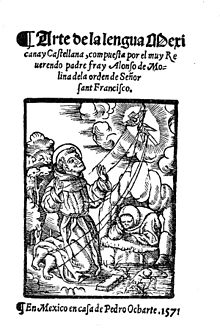In Aztec mythology, Tloquenahuaque, Tloque Nahuaque or Tloque Naoaque was one of the epithets of Tezcatlipoca. Miguel Leon Portilla argues that Tloque Nahuaque was also used as an epithet of Ometeotl, the hypothetical duality creator God of the Aztecs.
Historically Nahuatl has been written with greatly differing orthographies because no institution has governed its spelling. This is still true for the Classical Nahuatl dialect which is a dead language documented in many historical sources and literature, but spelling of the modern dialects of Nahuatl is governed by the Mexican Secretaría de Educación Publica, although they do have some difficulties in implementing their orthographic standards in the Nahuatl communities.

Antonio de Nebrija was the most influential Spanish humanist of his era. He wrote poetry, commented on literary works, and encouraged the study of classical languages and literature but his most important contributions were in the fields of grammar and lexicography. Nebrija was the author of the Spanish Grammar and the first dictionary of the Spanish language (1495). His grammar is the first published grammar study of any modern European language. His chief works were published and republished many times during and after his life and his scholarship had a great influence for more than a century, both in Spain and in the expanding Spanish Empire.
Classical Nahuatl is any of the variants of Nahuatl, spoken in the Valley of Mexico and central Mexico as a lingua franca at the time of the 16th-century Spanish conquest of the Aztec Empire. During the subsequent centuries, it was largely displaced by Spanish and evolved into some of the modern Nahuan languages in use today. Although classified as an extinct language, Classical Nahuatl has survived through a multitude of written sources transcribed by Nahua peoples and Spaniards in the Latin script.

Horacio Carochi (1586–1666) was a Jesuit priest and grammarian who was born in Florence and died in New Spain. He is known for his grammar of the Classical Nahuatl language.
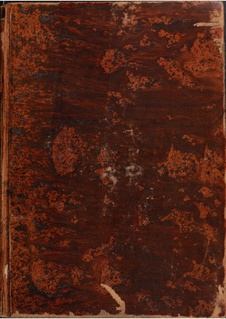
Alonso de Molina was a Franciscan priest and grammarian, who wrote a well-known dictionary of the Nahuatl language published in 1571 and still used by scholars working on Nahuatl texts in the tradition of the New Philology. He also wrote a bilingual confessional manual for priests who served in Nahuatl-speaking communities.

The Arte de la lengua mexicana con la declaración de los adverbios della is a grammar of the Nahuatl language in Spanish by Jesuit grammarian Horacio Carochi. This classic work on the Classical Nahuatl language is now considered by linguists to be the finest and most useful of the many extant early grammars of Nahuatl.

Andrés de Olmos was a Spanish Franciscan priest and grammarian and ethno-historian of Mexico's indigenous languages and peoples. He was born in Oña, Burgos, Spain and died in Tampico in New Spain. He is best known for his grammar, the first in the New World, of the Classical Nahuatl language.

Vocabulario en lengua castellana y mexicana is a bilingual dictionary of Spanish and Nahuatl by Alonso de Molina, first published in 1555 originally entitled Aquí comiença un vocabulario en la lengua castellana y mexicana, edited by Juan Pablos. It was the first dictionary to be published in the New World. However the most relevant and most famous edition was the one made in 1571, edited by Antonio de Spinosa, which then came to be named Vocabulario en lengua castellana y mexicana. This new edition included the Nahuatl-to-Spanish section that the original didn't.

The Arte para aprender la lengua mexicana is a grammar of the Nahuatl language in Spanish by Andrés de Olmos. It was written in Mexico in 1547, but remained in manuscript form until 1875, when it was published in Paris by Rémi Siméon under the title Grammaire de la langue nahuatl ou mexicaine. Olmos' Arte is the earliest known Nahuatl grammar.
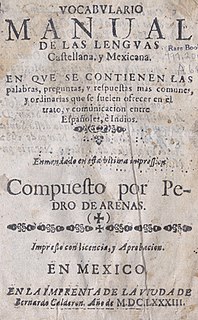
Vocabulario manual de las lenguas castellana y mexicana is a Spanish-Nahuatl dictionary by Pedro de Arenas, first published some time before 1611. It was one of the most popular Nahuatl dictionaries, going through at least eleven editions in 220 years.
Arte de la lengua mexicana is the title or part of the title of several grammars of Nahuatl:
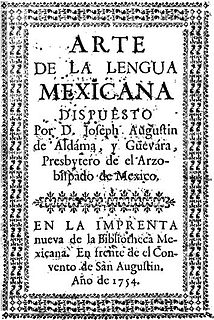
Arte de la lengua mexicana is a little-known grammar of the Nahuatl language by Joseph Augustin Aldama y Guevara published in 1754.
Antonio del Rincón was a Jesuit priest and grammarian, who wrote one of the earliest grammars of the Nahuatl language.
Pedro Ocharte was one of the first printers in the Americas, active from 1563 to 1592.

Gramatica de la lengua castellana is a book written by Antonio de Nebrija and published in 1492. It was the first work dedicated to the Spanish language and its rules, and the first grammar of a modern European language to be published in print. When it was presented to Isabella of Castile at Salamanca in the year of its publication, the queen questioned what the merit of such a work might be; Fray Hernando de Talavera, bishop of Avila, answered for the author in prophetic words, as Nebrija himself recalls in a letter addressed to the monarch:
After Your Highness has subjected barbarous peoples and nations of varied tongues, with conquest will come the need for them to accept the laws that the conqueror imposes on the conquered, and among them our language; with this work of mine, they will be able to learn it, as we now learn Latin from the Latin Grammar
Classical Otomi is the name used for the Otomi language as spoken in the early centuries of Spanish colonial rule in Mexico and documented by Spanish friars who learned the language in order to catechize the Otomi peoples. During the colonial period, many Otomis learned to write their language in Roman letters. As a consequence, a significant number of documents in Otomi, both secular and religious, exist from the period, and the most well-known documents are the Codices of Huichapan and Jilotepec. Text in classical Otomi is not easily accessible since the Spanish speaking friars failed to differentiate the varied vowel and consonant sounds of the Otomi language.

Chalchicomula de Sesma Municipality is a municipality in Puebla in south-eastern Mexico.
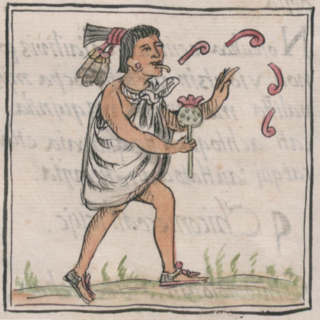
Nahuatl or Mexicano is a language or group of languages of the Uto-Aztecan language family. Varieties of Nahuatl are spoken by about 1.7 million Nahua peoples, most of whom live mainly in Central Mexico, and a small number live in Nahuatl speaking communities in the U.S.
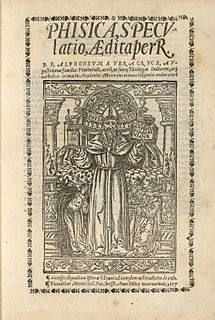
Giovanni Paoli, better known as Juan Pablos, a native of Lombardy, was the first documented printer in the Americas when he started printing in Mexico in 1539.
